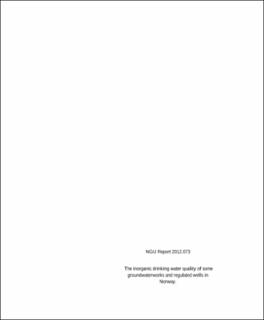| dc.description.abstract | A selection of 351 wells and\/or springs serving public waterworks registered at Nasjonalt folkehelseinstitutt (Norwegian Institute of Public Health) and 302 wells and\/or springs registered at Mattilsynet (Norwegian Food Safety Authority) were analysed at NGU lab for anions, cations, and a long range of trace elements as well as pH, alkalinity, turbidity, colour, and electrical conductivity.Groundwater samples from bedrock boreholes are generally more mature than samples from wells in Quaternary unconsolidated sediments. This is shown by higher pH, alkalinity, and electrical conductivity as well as higher concentrations of most elements (except nitrate, aluminium and copper). The bedrock groundwater samples comprised generally the following water types based on dominating ions: Ca-HCO3 type waters 77% ; Na-HCO3 type waters 15%; Na-CI type waters 6%; others 2%. The groundwater samples from unconsolidated sediments included the following water types: Ca-HCO3 type waters 68% ; Na-CI type waters 13% ; Na-HCO3 type waters 9% ; Ca-CI type waters 6% ; Ca-S04 tvpe waters 4%. In total, 51.5% of the water samples do not meet all the requirements in the current drinking water quality egulations. Elevated levels of manganese and\/or iron are a common problem both in groundwater from bedrock wells (28% and 10.2%, respectively) and from unconsolidated Quaternary sediments (21.4% and 10.8%, respectively). A few samples breach the drinking water limits for arsenic and molybdenum (0.9% and 0.6% in bedrock wells, respectively), while the levels of cadmium, chromium, nitrate, and antimony are lower than the limits for all samples. Elevated copper, lead, and nickel concentrations seem to be due to leaching from water pipes and fittings as the levels are higher in water samples from private wells than from waterworks. In Norway, no limits are defined for uranium in drinking water. 7.2% of bedrock boreholes have uranium concentrations above the WHO guideline of 30 microgram\/L.The dataset cannot be used to make a hydrogeochemical map of Norway. A few anomalies can however be found, such as elevated yttrium and rare earth element concentrations in groundwater from Quaternary aquifers in southernmost Norway. | |

